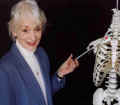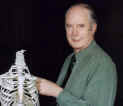 |
 |
 |
Helping You To Achieve ©™

![]()
Helping You To Achieve ©™
|
|
Draw with a skin marking pencil the position of the Greater Trochanter of Femur on a model in the Anatomical position with side lighting and a time limit of one minute.
Objective No 87 - Criteria to be demonstrated. 1. Identify and surface mark the Anterior Superior Iliac Spine of the Iliac Crest following the steps in Objective No 86. 2. Identify and surface mark the most prominent point of the Ischial Tuberosity following the steps in Objective No 88. 3. Draw a line from the Anterior Superior Iliac Spine to the most prominent point of the Ischial Tuberosity. 4. The Line drawn crosses superior aspect of the Greater Trochanter of the Femur and the centre of the Acetabulum of the Inominate bone forming the Hip Joint. 5. The Greater Trochanter of the Femur is subcutaneous in its inferior part and presents a quadrilateral bony shape. 6. Place the palm of the model on the lateral aspect of the Hip area with the finger tips parallel and together facing in an anterior direction and the Thumb resting just inferior to the Iliac Crest. 7. The Medial border of the fifth finger is placed superior to the subcutaneous quadrilateral prominent bony mass of the Greater Trochanter of the Femur.
|
Service ProvisionBronze. Students may take up a ,'Free start up ' package consisting of 100 of the behavioural objectives and criteria based on common questions asked in Living Anatomy. These are available free of charge on this Website. Silver. Students may buy a copy of the book "Surface and Living Anatomy" (ISBN: 0 7234 3261 9) which comes with a CD Rom (Windows PC format) containing 230 objectives which includes the 100 behavioural objectives contained in the Bronze Service. Gold "Helping you to Achieve" Contact Information
|